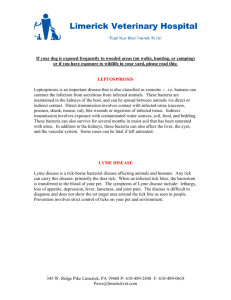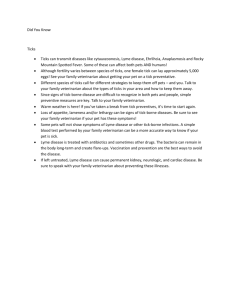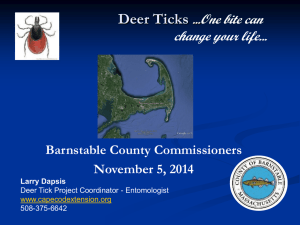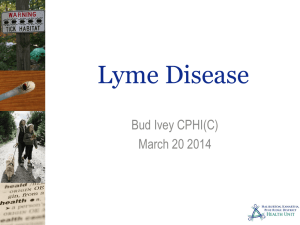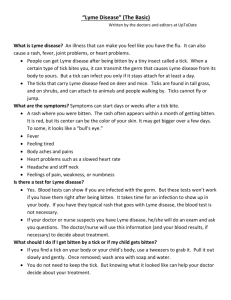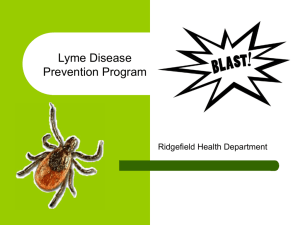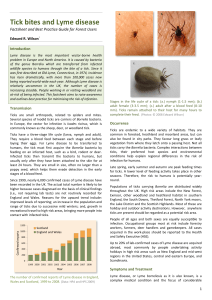Lyme Disease Fact Sheet - Cecil County Health Department
advertisement
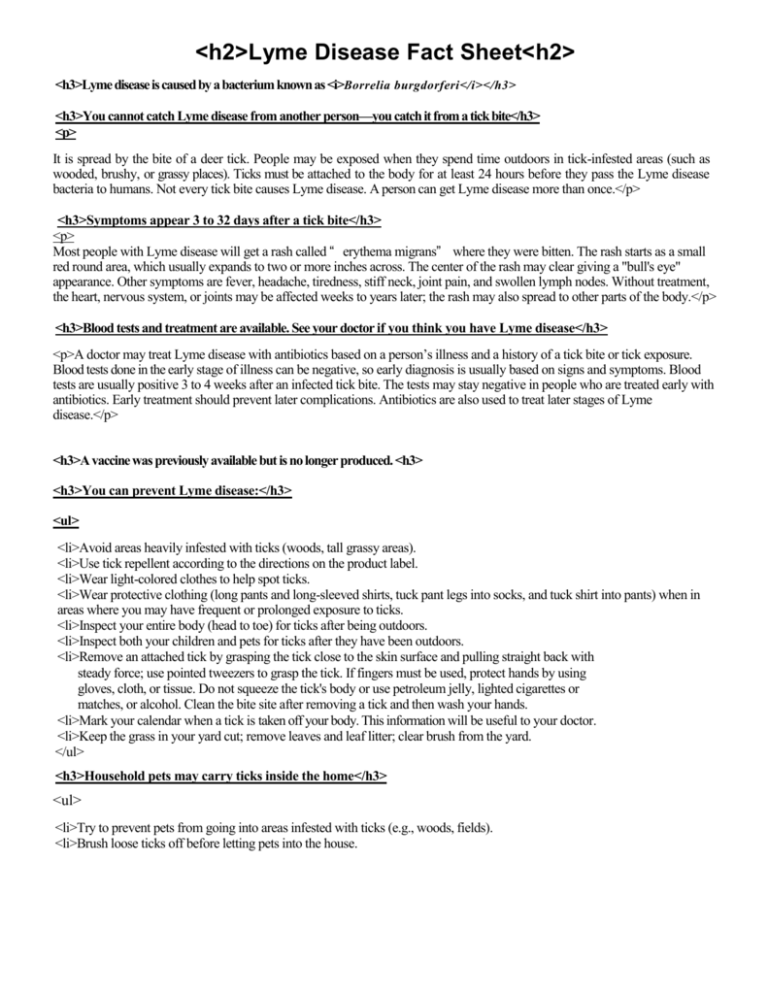
<h2>Lyme Disease Fact Sheet<h2> <h3>Lyme disease is caused by a bacterium known as <i>Borrelia burgdorferi</i></h3> <h3>You cannot catch Lyme disease from another person—you catch it from a tick bite</h3> <p> It is spread by the bite of a deer tick. People may be exposed when they spend time outdoors in tick-infested areas (such as wooded, brushy, or grassy places). Ticks must be attached to the body for at least 24 hours before they pass the Lyme disease bacteria to humans. Not every tick bite causes Lyme disease. A person can get Lyme disease more than once.</p> <h3>Symptoms appear 3 to 32 days after a tick bite</h3> <p> Most people with Lyme disease will get a rash called “ erythema migrans” where they were bitten. The rash starts as a small red round area, which usually expands to two or more inches across. The center of the rash may clear giving a "bull's eye" appearance. Other symptoms are fever, headache, tiredness, stiff neck, joint pain, and swollen lymph nodes. Without treatment, the heart, nervous system, or joints may be affected weeks to years later; the rash may also spread to other parts of the body.</p> <h3>Blood tests and treatment are available. See your doctor if you think you have Lyme disease</h3> <p>A doctor may treat Lyme disease with antibiotics based on a person’s illness and a history of a tick bite or tick exposure. Blood tests done in the early stage of illness can be negative, so early diagnosis is usually based on signs and symptoms. Blood tests are usually positive 3 to 4 weeks after an infected tick bite. The tests may stay negative in people who are treated early with antibiotics. Early treatment should prevent later complications. Antibiotics are also used to treat later stages of Lyme disease.</p> <h3>A vaccine was previously available but is no longer produced. <h3> <h3>You can prevent Lyme disease:</h3> <ul> <li>Avoid areas heavily infested with ticks (woods, tall grassy areas). <li>Use tick repellent according to the directions on the product label. <li>Wear light-colored clothes to help spot ticks. <li>Wear protective clothing (long pants and long-sleeved shirts, tuck pant legs into socks, and tuck shirt into pants) when in areas where you may have frequent or prolonged exposure to ticks. <li>Inspect your entire body (head to toe) for ticks after being outdoors. <li>Inspect both your children and pets for ticks after they have been outdoors. <li>Remove an attached tick by grasping the tick close to the skin surface and pulling straight back with steady force; use pointed tweezers to grasp the tick. If fingers must be used, protect hands by using gloves, cloth, or tissue. Do not squeeze the tick's body or use petroleum jelly, lighted cigarettes or matches, or alcohol. Clean the bite site after removing a tick and then wash your hands. <li>Mark your calendar when a tick is taken off your body. This information will be useful to your doctor. <li>Keep the grass in your yard cut; remove leaves and leaf litter; clear brush from the yard. </ul> <h3>Household pets may carry ticks inside the home</h3> <ul> <li>Try to prevent pets from going into areas infested with ticks (e.g., woods, fields). <li>Brush loose ticks off before letting pets into the house. <li>Remove all ticks in the same way you would from yourself. <li>Talk to your veterinarian about tick control products. </ul> <p align=”center” class=”abrnsm”>Maryland Department of Health & Mental Hygiene - Epidemiology & Disease Control Program</p>
